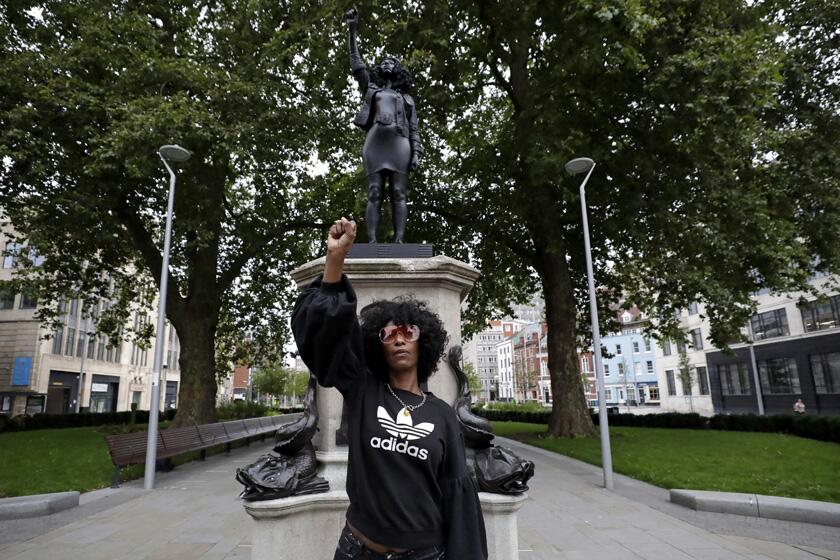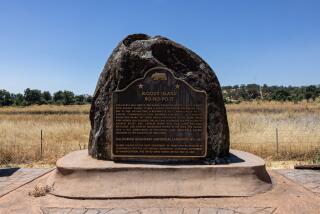Column: It’s time to chop down the ‘lynching tree’ from this California city’s logo
As night follows day, cries of “historical erasure” go up across the land when pro-Confederacy monuments come down.
The complaints are almost always wrong. Most of the toppled statues, markers and symbols of the Confederacy are modern examples of Jim Crow propaganda, not memorials to honor heroic events of the grisly Civil War. Confederate monuments typically rewrite the past, sugarcoating truth. Yelling “Save history!” is just a way to cover bias with a respectable veneer of erudition.
Night immediately followed day recently in little Placerville, Calif., when a push to change the graphic design of the municipal logo ended up before the City Council. This time Confederate sympathies were not at issue. Instead, a loosely related matter of vigilante killing was.
Placerville’s town logo features a lynching tree.
It might seem odd for a small town, population about 11,000, to proudly identify itself with a history of lynching — especially when tourism is a primary driver of the local economy. But the image of a rope noose dangling from the limb of a mighty oak stands out on the city emblem.
The idea for removing the controversial noose from the drawing was first brought to the City Council in June, then discussed in a July 14 Zoom meeting — complete with an hour of public comment, pro-noose and anti-. Money didn’t seem to be the issue, since a redesign was estimated to cost only about $5,350 for labor and fees.
But the council punted. A vote to postpone a decision until next year, after pandemic restraints on in-person debate are lifted, passed 4 to 1.
Letter writers to the Mountain Democrat, the local newspaper that reported the testy meeting, immediately yelped.
“Let’s not erase our history,” insisted one.
Erasure of the lynching tree represents “a liberal force trying to remove history,” cried another.
“Please do not remove the history of our town,” begged a third, while a fourth contended that “Old Hangtown is just a historical statement.”
Old Hangtown is what Placerville got nicknamed before it was much more than an improvised 19th century mining camp set up next to a modest creek. It sits barely 10 miles from the spot where James W. Marshall stumbled on some glittery metal flakes at the water-powered sawmill owned by his boss, German-born Swiss immigrant John Sutter. The burg was instrumental in the epochal California Gold Rush that kicked off in 1848.
That history is nothing to be sneezed at. Placerville became a distribution center in a supply chain that saw billions mined from the Gold Rush fields in the Sierra foothills east of Sacramento (not much is left). California’s non-Indigenous population zoomed from about 800 to more than 100,000 by the end of the next year. Just 20 short months after the first gold strike, the Golden State joined the Union.
The stampede of new arrivals led to a national transformation in ways improvised, planned, sometimes unwanted and often unexpected. In the process, a thousand yarns were spun — elaborate tales of phenomenal good fortune, dashed hopes and bloody mayhem. Each Gold Rush story seems to have spawned another and another, multiplying like “Star Trek” Tribbles.
History easily blurs into myth and legend, and sorting among them is perilous. But wild and lawless treasure-hunting surely ignited the Hangtown nickname — a violent place where “they hang ‘em first and question ‘em later,” as a cheery local saying goes.
One credible story had a trio of desperadoes getting caught after robbing the sleeping owner of a gambling parlor of his gold-dust stash and threatening his life. He may have been murdered (accounts vary). A makeshift judge and jury were convened on the spot and the trio was convicted, sentenced to death and promptly strung up from a massive oak tree at a place next door known as Elstner’s hay yard.
The lynchings kept coming.
Three other scoundrels were hanged for horse-stealing, another for holding up a hapless miner in his cabin. “Irish Dick” — one Richard Crone, lately from New Orleans — was hanged for using his trusty Bowie knife to separate a gambler’s beating heart from his chest after an insult at the card table.
A mob lynched five for rolling a visiting Mexican gambler — maybe Placerville’s first instance of civic concern over imperiling the tourist trade.
The graphic design of the Placerville logo springs from all this. The picture tells a very simple tale.
Shouldn’t public monuments have public input? In the George Floyd moment, artists and designers are changing the nature of monuments and the histories they honor.
A rope frame encircles a flatly painted, cartoon-like image in which a bearded miner pans for gold in the foreground, his crouched body ethereally framed by a puffy white cloud floating in a clear blue sky. That big oak tree dangling a noose stands behind him, like a distant sentinel.
Prominent rustic lettering names the city of Placerville, which ditched the Old Hangtown nickname in 1854. The date and canceled name are modestly represented on the logo.
Originally the town had just been called Old Dry Diggins, an informal reference to the method for surface-mining minerals in the absence of water; but that history is omitted from the logo. Hangtown’s emergence shifted the vernacular, issuing an unsubtle warning to potential thugs.
Soon, a thorny predicament surfaced. The ballyhooed practice of lynching proved to be less than useful for a growing village that hankered to replace Coloma, dusty site of Sutter’s Mill, as the seat of booming El Dorado County.
Hangtown had a nasty image problem. Rampant extra-legal killing doesn’t quite square with an establishment desire for civic power.
To make a credible appeal to gain governing authority, residents needed to shake off a sordid reputation for vigilante justice. The town postmaster, apparently urged on by local churches and a busy temperance league, is said to have sought something a bit more dignified.
Thus was Placerville born. Placer mining, which is a method of sifting mineral deposits from a stream bed, fit the tasteful makeover bill.
Within four years of the spectacular Sutter’s Mill find, an official new moniker was in place. Today’s disputed municipal logo essentially pictures a name change: Lawless Hangtown is on the far horizon, off in the background, and hardworking Placerville takes pride of place up front.
Who designed the logo, and when, I cannot say. City officials told me they are not quite sure how long it has been in use — perhaps since early in the 20th century, certainly before 1970 — and the artist’s name is apparently lost. But it is easy to see why many people today would be offended by a visual salute to vigilante justice, which is more accurately described as mob rule.
In particular, the offense of a lynching tree grows stark in the era of Black Lives Matter, when the nation is finally wrestling with a pervasive legacy of white supremacy. (As the Botswana-born, former L.A.-based artist Meleko Mokgosi recently put it, “America does not simply have a race problem, America is a race problem.”) Between post-Civil War Reconstruction and World War II, more than 4,400 racial terror lynchings took place across the United States. The logo can’t help but conjure those vicious crimes.
That horrific vigilante history might be separate from earlier events in Placerville, but California’s Gold Rush is hardly immune from the grim specter of racial brutality. Sutter himself enslaved hundreds of Indigenous people as a free source of labor. Some among them led Marshall to the gold, which he euphemistically “discovered.” Rape was one ghastly tool of Sutter’s coercion, as he assembled what an observer described as a “harem” of American Indian women and girls.
An 800-pound marker for the Jefferson Davis National Highway has been removed from view. A college student’s email prompted the change.
In the year of the Hangtown name-change, the new state’s fledgling Supreme Court added Chinese people to the exclusionary list of Black and Indigenous people already forbidden in local ordinances from testifying against whites in legal proceedings. Thomas Nast, the brilliant editorial cartoonist, working later in Harper’s Weekly — self-styled Journal of Civilization, as its banner read — mocked the California court’s decision in People v. Hall.
Juxtaposing caricatured figures representing the American South and West, Nast’s pen dripped acid. In essence, he wrote, the ruling claimed that “The poor barbarians can’t understand our civilized Republican form of government.”
So what is Placerville to do now with the dicey bit of prominent local lynching history on its municipal logo? Here’s a suggestion: Take a cue from the solution to the image problem that first gave the town its name. Don’t erase the lynching tree, cut it down.
Redesign the graphic so that the oak, its offending limb and the dangling noose sprawl on the ground, while the chopped stump is left behind. That is, after all, what really happened.
In 1853, the townsfolk did cut down the big oak tree in Elstner’s hay yard, where all those convenient mob executions had taken place. Ending the practice of lynching was essential to spiffing up the reputation of the soon-to-be newly named Placerville. Four years later the California legislature chose the scrappy town to be the El Dorado County seat. The image rehab succeeded.
That’s the story a smartly redesigned logo could tell — a success story of forsaking something barbaric in favor of something civilized. The current logo misses the key point, making it just bad history.
The lynching tree’s stump still exists, too, hiding in plain sight. A bronze plaque installed out front of a former saloon built on the site of Elstner’s hay yard explains, “The stump of the tree is under this building.” Since 1934 — the 80th anniversary of the city’s name-change — the humble stump has been State Historical Landmark No. 141, marked with a sign on what is now Main Street.
In the pit of the Great Depression, honoring the stupendous riches of the Gold Rush legacy gave hope. For Placerville’s long history, the stump matters most, not the noose.
Time to bring it into the light. So scrap the dangling noose on the town logo and cut down the tree. Repeal a civic memorial to mob rule and replace it with a commemoration of civilized progress.
That’s authentic Golden State history. Who could possibly object?
More to Read
The biggest entertainment stories
Get our big stories about Hollywood, film, television, music, arts, culture and more right in your inbox as soon as they publish.
You may occasionally receive promotional content from the Los Angeles Times.












